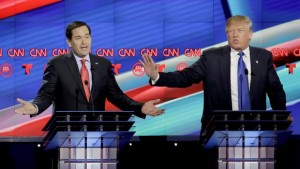Just in time for Super Tuesday, Marco Rubio displayed a different side of Rubio on Thursday night on the Republican GOP debate.

Photo courtesy of USA Today
Rubio, who had been known particularly as the little boy with big dreams in the Republican race for the presidential nomination showed a new face Thursday night, as he hit Donald Trump repeatedly with attacks that appeared to get under Trump’s skin and throw him off. Rubio suddenly appeared as a strong competitor with the power and drive to potentially become president. The Atlantic magazine called this debate “Trump’s worst debate of the campaign”.
Rubio appeared to be more prepared this time with his research and words than in the last debate, where he was stumped on by former Republican candidate Chris Christie. In the last debate in New Hampshire, Rubio appeared to be repeating himself with a speech Christie jeered by being written by Rubio’s advisors. He continued to bash Rubio during the debate saying, “There it is. There it is. The memorized 25-second speech!”
This time around in Texas, Rubio turned the same call out to Trump.
“He’s repeating himself!”
-Marco Rubio
The most entertaining thing about the Texas Republican GOP Debate was that each time Rubio knew he hit Trump and was awarded with seemingly undying yells and applause, he had a huge grin on his face. Trump is known for echoing the same set of slogans over his entire campaign such as: Make America great again, Build the wall, and Stop losing at trade. As he forced Trump off his pedestal and threw him off, Trump appeared to get lost and confused without having his mantras backing him up. You could say that Rubio had ‘trumped’ Trump.
Trump didn’t much debate back, but instead tried to shoot back insults in an attempt to bring himself back up. But each time Rubio was ready to shoot back. He was much different than the Rubio who fell to Chris Christie in New Hampshire. This time much more agile and aggressive with an unending supply of opposition research to hit Trump with.
Now how does all this relate to real news? In our modern day, much news is spread through technology, especially with social media. Following this debate, Rubio released a series of tweets with the hashtag, ‘#NeverTrump’.
#NeverTrump has been a movement on Twitter, pushed by tweet-centered republicans who are aiming to compel voters not to support Trump through using a viral hashtag that can be seen anywhere and spread infinitely. Rubio’s tweet was posted on Friday following the debate Thursday night.

Photo courtesy of Marco Rubio’s Twitter account
The hashtag means that even if Trump were to get the republican nomination, even conservative voters would vow to vote for the opposition, as they believe that never would Trump be president.
Rubio used his lasting strength from the debate and combined it with today’s “word of mouth” which is social media to continue his campaign. He tweeted “#NeverTrump. Agree? Add your name here,” with a link directing to his campaign website to support his campaign. Hashtags have become a creative and effective way to spread word quickly and virally through social media, and Rubio knew it would come handy in his favor to continue to attack Trump.








 d to report.
d to report.







